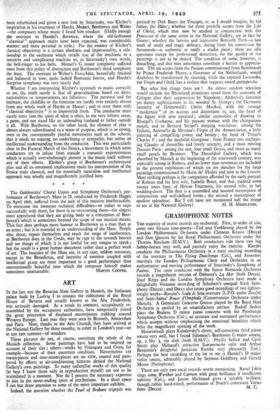ART
IN the late war the Bavarian State Gallery in Munich, the Italianate palace built by Ludvig I to contain the collections of the Royal House of Bavaria and usually known as the Alte Pinakothek, was seriously damaged. As a result its contents, scrupulously re- assembled by the occupation authorities, have temporarily joined the great procession of displaced masterpieces trekking around Western Europe. Last year they were seen in Brussels, Amsterdam and Paris. Now, thanks to the Arts Council, they have arrived at the National Gallery for three months, to usher in London's year—or at any rate summer—of wonders.
These pictures do not, of course, constitute the whole of the Munich collection. Some paintings have had to be omitted on account of their size; others—works by Velasquez and Goya, for example—because of their -uncertain condition. Nevertheless 121 masterpieces and near-masterpieces are on view, coaxed and pam- pered by efforts at air-conditioning hitherto denied the National Gallery's own paintings. So many unfamiliar works of this quality (at best I knew them only in reproduction myself) are not to be assimilated in a moment. Nor do I possess the necessary expertise to join in the never-ending sport of attributions. In a short space I can but draw attention to some of the more important exhibits.,
Indeed, the question whether the Pearl of Brabant triptych was
painted by Dirk Bouts the Younger, or, as I would imagine, by his father, the Elder ; whether the three predella scenes from the Life of Christ, which may now be studied in conjunction with the Pentecost of the same series in the National Gallery, are in fact by Giotto ; whether the famous and impressive Botticelli Pieta—a late work of steely and tragic delicacy, dating from his conversion by Savanarola—is authentic or really a studio piece ; these are idle questions except for professional detectives, for the quality of the paintings is not to be denied. The condition of some, however, is disturbing, and this may sometimes constitute a barrier to apprecia- tion. The six scenes from the Passion commissioned from Rembrandt by Prince Frederick Henry, a Governor of the Netherlands, would doubtless be transformed by cleaning, while the reputed Leonardo, the Virgin and Child, has a surface that suggests rotted guttapercha.
But what fine things there are ! An almost random selection would include the Rhineland primitives saved from the convents of Cologne after their suppression by Napoleon ; Altdorfer's fantastic yet dainty sophistication in his wooded St. George ; the Germanic intensity of Grunewald's Christ Mocked, with the strange " modernity " of its accents and distortions in, say, the head of the figure with arm upraised ; similar curiosities of drawing in Bruegel's Cockayne, and his peasant woman with the chimpanzee mouth, and in Bernard Strigel's sleeping watchman: among the Italians, Antonello da Messina's Virgin of the Annunciation, a little painting of compelling power and beauty ; the head of Titian's Charles V ; and the doubtful Giorgione : from France two enchant- ing Claudes of dreamlike and lovely serenity, and a most moving Poussin Pieta : among the rest, four small Goyas, and twice as many small panels by Brouwer. The Dusseldorf Gallery, which was absorbed by Munich at the beginning of the nineteenth century, was especially strong in Rubens, and no fewer than seventeen are included in the present exhibition—of which six are sketches for the large paintings commissioned by Maria de' Medici and now in the Louvre. Most striking perhaps is the comparison afforded by the early portrait of Rubens and his first wife, Isabella Brant, and that, painted some twenty years later, of Helene Fourment, his second wife, in her wedding-dress. The first is a controlled and 'assured masterpiece of composition and well-defined forms ; the second a masterpiece of opulent splendour. But I still have not mentioned half the things
to see at the National Gallery! M. H. MIDDLETON.


































 Previous page
Previous page